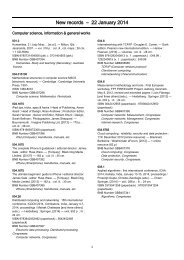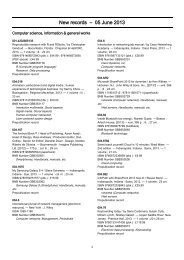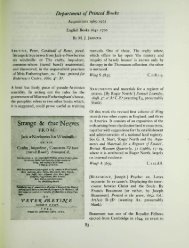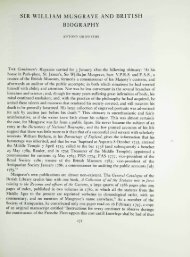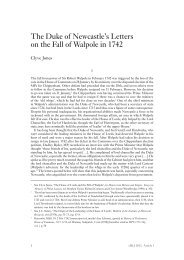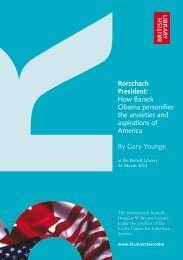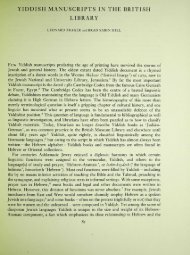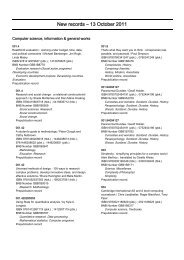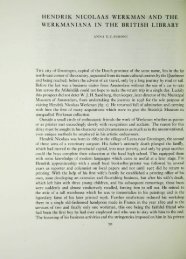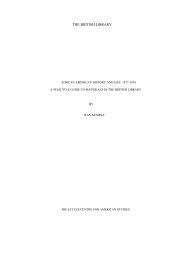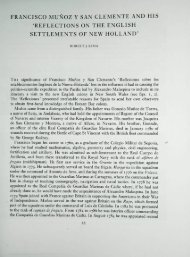A Medieval Psalter 'Perfected': Eighteenth-Century ... - British Library
A Medieval Psalter 'Perfected': Eighteenth-Century ... - British Library
A Medieval Psalter 'Perfected': Eighteenth-Century ... - British Library
Create successful ePaper yourself
Turn your PDF publications into a flip-book with our unique Google optimized e-Paper software.
A <strong>Medieval</strong> <strong>Psalter</strong> ‘Perfected’: <strong>Eighteenth</strong>-<strong>Century</strong> Conservationism and an Early (Female) Restorer<br />
of Rare Books and Manuscripts<br />
apprehensions were twice confirmed. At the end of the nineteenth century, a brief on the state<br />
of her charitable bequests ended on a sombre note: ‘[t]he stone over the grave of John and<br />
Martha Denyer is now covered up. No part of the income is applied towards the repair of<br />
the tablet, a plain marble slab’. 37 And in the destructions of World War II, the tablet suffered<br />
even further, left as a collection of shards from the bombing of April 1943. This story of<br />
encroaching oblivion does, however, have a poetic ending: just as Denyer reconstructed the<br />
remains of the printed and illuminated books of the past, so the parishioners of Chelsea Old<br />
Church reassembled the Denyer memorial, which today can be seen intact in its original home. 38<br />
Denyer and Late <strong>Eighteenth</strong>-<strong>Century</strong> Restoration<br />
A number of later notices draw attention to Eliza’s ‘talents in illumination, miniatures<br />
and repairing old MSS’, 39 and Thomas Faulkner’s panegyric to her gifts is effusive:<br />
Miss Denyer [...] who possessed uncommon talents, was extremely clever in<br />
painting and illuminating on vellum, and in repairing old Manuscripts and<br />
printed books; her drawings and miniatures were equal to the finest specimens<br />
which the middle ages could produce. The inspection of these beautiful<br />
specimens of her pencil never failed to excite the most profound sentiments of<br />
admiration and esteem, which were ever augmented by the consideration that<br />
in her exemplary character was blended true Christian benevolence with the<br />
utmost diffidence, filial affection, and private worth. 40<br />
Stripped of its saccharine ornaments, Faulkner’s praise still conveys a number of details useful<br />
to the appreciation of Denyer’s career: first, that her exercises were rare for the time, or at least<br />
that her talents were; second, that she was known to have repaired both printed books and<br />
manuscripts; third, that she created her own illuminations in a style evocative of medieval art;<br />
and finally, that she may have shared her work with others. Significantly, this as well as all other<br />
known references to Eliza as an illuminator were written well into the nineteenth century, when<br />
a critical mass of both participants and commercial support made such activities intelligible as<br />
a learned and cultured pursuit. But was she rare for her time? Or, were there others like her<br />
at this early period restoring rare books and manuscripts in a similar fashion? This question is<br />
one that I can only answer summarily here; but there is reason to believe that there was a small<br />
group of others who engaged in similar enterprises, or at the very least, that Denyer was on the<br />
37<br />
Endowed Charities (County of London). Reports and Digest of Endowed Charities. Parish of Chelsea, 1897 (222),<br />
p. 23.<br />
38<br />
I am very grateful to Trish Coleridge, Parish Administrator of Chelsea Old Church, who offered valuable<br />
information about the memorial tablets and their restoration after 1943.<br />
39<br />
Godfrey, Survey of London, pt. ii, p. 66.<br />
40<br />
Faulkner, An Historical and Topographical Description of Chelsea, vol. i, p. 262. Similar praise (probably taken<br />
from Faulkner’s description) appears in Bryan, Chelsea in the Olden and Present Times, p. 91. Eliza is also<br />
referred to as an ‘illuminator of missals’ in Wentworth, ‘Chelsea: A Lecture Delivered in the Town Hall’, p. 9.<br />
41<br />
See above, n. 1, as well as Janet Backhouse, ‘Pioneers of Modern Calligraphy and Illumination’, The <strong>British</strong><br />
Museum Quarterly, xxxiii (1968), pp. 71-9. It is also worth noting that the activity of illumination and restoration<br />
became popular among women in the nineteenth century and included among its practitioners Queen Caroline<br />
(1768-1821) as well as a Lady Strange, who replaced a missing initial in a Book of Hours of York Use (Boulogne<br />
sur-Mer, MS. 93). See John Block Friedman, ‘<strong>Medieval</strong>ism and a New Leaf by the Spanish Forger’, Studies in<br />
<strong>Medieval</strong>ism, xi (2001), pp. 213-38; and Rowan Watson, Illumination and Illuminated Manuscripts: A Survey of<br />
Responses in England, France and Germany to the Revival of a <strong>Medieval</strong> Art Form (London, 1997).<br />
25<br />
eBLJ 2013, Article 3



